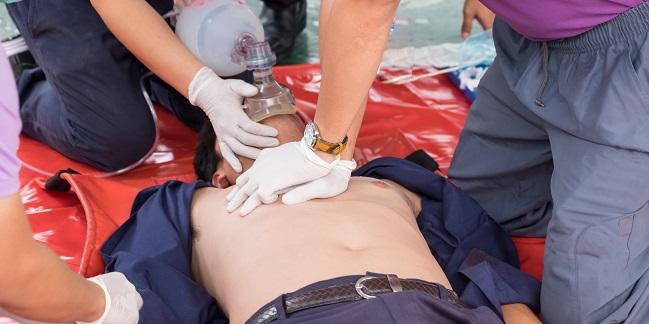Sodium Nitrite Fails to Improve Survival in Out-of-Hospital Cardiac Arrest
The results were unexpected given prior animal research showing as much as a 50% improvement in survival.

Given the dire survival rate from out-of-hospital cardiac arrest—about 20%—and animal studies showing as much as 50% increased survival when sodium nitrite was given during resuscitation, Francis Kim, MD (University of Washington, Seattle), who presented the findings last week at the virtual American College of Cardiology 2020 Scientific Session, explained that there was “a very compelling rationale to perform this randomized study.”
However, he said, “these data suggest that the use of sodium nitrite for out-of-hospital cardiac arrest should be abandoned and not pursued further.”
No Difference in Survival
Kim and colleagues worked with emergency medical services (EMS) in Seattle and surrounding King County to randomize adult patients with nontraumatic, out-of-hospital cardiac arrest to one of two intervention arms—sodium nitrite 60 or 45 mg—or placebo. To be included, patients had to be unconscious, able to be accessed intravenously or intraosseously, to not have a known DNR, and to not be pregnant, a prisoner, or drowning.
Of the 1,492 patients enrolled, mean age was in the low 60s and about two-thirds were men. About one in five were in ventricular fibrillation, about 90% went into cardiac arrest before EMS arrival, and just over 40% had a witnessed arrest. The mean time from call to EMS arrival was about 6 minutes while the mean time from call to randomization was 22 minutes.
A total of 635 patients survived to hospital admission, with no differences observed between the study groups (all around 40%; P > 0.5 for comparison). A similar pattern was observed for only those in ventricular fibrillation, although their survival rate was closer to 70% (P > 0.05 for comparison). There were also no differences between each study arm and the placebo group in a post hoc analysis looking at survival to discharge.
Sodium nitrite was safe with no differences observed between the study groups with regard to return of spontaneous circulation, norepinephrine and epinephrine dosing, rearrest, systolic BP after randomization, and ICU days.
Discussing Factors That Come Into Play
Discussing the findings during the session, Craig Beavers, PharmD (University of Kentucky, Lexington), applauded the researchers for “trying to tackle a very challenging problem that we . . . are trying to find great solutions and answers for.” He asked whether there were any variations based on whether an arrest was witnessed or whether cardiopulmonary resuscitation (CPR) was performed.
Kim said the outcome was similar after adjustment for age, witnessed arrests, time to arrival of the paramedics, and CPR. “There was no difference between placebo and both doses of sodium nitrite,” he said.
Tyler Gluckman, MD (Providence Heart and Vascular Institute, Portland, OR), also noted that within the population with ventricular fibrillation, “there seems to be somewhat of at least a trend toward a dose response where the 60 mg dose was trending toward benefit. Maybe this is just my eyes playing tricks on me, but is there any rationale do you think for additional investigation looking at higher doses to determine whether or not in that population in particular, albeit with a higher chance of survival, there may be a rationale for further evaluation?”
Kim replied that if given at too high of a dose, sodium nitrite can cause neurologic damage, so “we were very careful in terms in not pursuing a higher dose. Our 60-mg dose is our best guess to get to the target dose, and I don’t think a higher dose would actually make a difference and then we would worry about potential harm.”
Lastly, Mitchell Faddis, MD, PhD (Washington University School of Medicine in St. Louis, MO), described the work as a “remarkable trial to pull off.” He called the prior animal research “very compelling,” noting: “It just makes me wonder if there’s something about the hypothesis that the nitrite scavenges the oxygen free radicals, generates the nitric oxide in situ in the brain, and the heart maybe helps there. It just seems like such a great hypothesis with good backing.”
Perhaps the time to infusion is “the major issue here,” he suggested. “I'm wondering whether or not there's some wiggle room there, that if you'd got rather than 20 minutes into the resuscitation if it had gone in earlier and if you look at the data based on the time to infusion if that made a difference in the outcome.”
“That’s an excellent question,” Kim replied, “and one that we’ve been struggling with. There is a real-world limitation in terms of how fast we can give the drug from the time that the patient actually has a cardiac arrest to drug delivery. The 22 minutes we feel is the best-case scenario and when we compare our study with other studies, such as the PARAMEDIC2 trial, time from call to epinephrine delivery at that time was about 20 minutes as well. So we may be hitting [a limit] in terms of how fast we can deliver any kind of drug to help with ischemia reperfusion injury.”
Yael L. Maxwell is Senior Medical Journalist for TCTMD and Section Editor of TCTMD's Fellows Forum. She served as the inaugural…
Read Full BioSources
Kim F. Randomized clinical trial of pre-hospital sodium nitrite in out-of-hospital cardiac arrest patients. Presented on: March 29, 2020. ACC 2020.
Disclosures
- The study was funded by the National Institutes of Health/National Heart, Lung, and Blood Institute.
- Kim reports no relevant conflicts of interest.


Comments